
Keldby Church, famous for its frescoes, is located on the main road to Møns Klint in the village of Keldby, 4 km east of Stege on the Danish island of Møn.

St. Peter's Church is a Romanesque parish church some 6 km east of Aakirkeby on the Danish island of Bornholm. It is thought to be the oldest church on the island.

Væggerløse Church is a Romanesque church in the village of Væggerløse, 7 kilometres (4.3 mi) south of Nykøbing on the Danish island of Falster. Its early 16th century frescos depict the Supper at Emmaus.

Aastrup Church, located on the top of a steep hill in the village of Aastrup, 6 kilometres (3.7 mi) southwest of Stubbekøbing on the Danish island of Falster, dates from c. 1200. Built in the Late Romanesque style, it has frescos from the 13th and 15th centuries.

Torkilstrup Church is located in the village of Torkilstrup some 7 km (4 mi) southeast of Nørre Alslev, on the Danish island of Falster. It is built of hewn fieldstone rather than brick, indicating it is one of the oldest churches on the island from before 1160.

Stubbekøbing Church is located in Stubbekøbing some 18 km (11 mi) northeast of Nørre Alslev on the Danish island of Falster. The basilical nave was built of limestone in the Late Romanesque period. Choir and tower are of brick, the choir built in Early Gothic style, tower and the northern chapels in the 15th century in Late Gothic style. In addition to its Renaissance altarpiece and pulpit, it has a variety of old frescos and wall decorations (1300–1500).

Eskilstrup Church is a church in Eskilstrup, Denmark. The church dates from the 12th century and was built in the Romanesque style. In accordance with a local tradition, it is painted red. It is best known for its frescos, said to be Denmark's oldest.

Freerslev Church is located in the Danish Diocese of Roskilde, Faxe Municipality in Region Sjælland on the island of Zealand. Parts of the original Romanesque church subsist today although there have been substantial Gothic additions. Primitive 14th-century frescos have been uncovered in the arch of an old window on the north wall.

Toreby Church is the parish church of Toreby on the Danish island of Lolland. It is an unusually large red-brick Romanesque building, the nave and chancel having been extended in the Gothic period with a sacristy and lateral aisle. The tower is late Romanesque. There are frescos from c. 1400 in the sacristy. The carved pulpit (1645) is the work of Jørgen Ringnis.
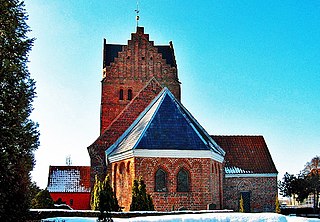
Stokkemarke Church is located in the village of Stokkemarke some 11 km (6.8 mi) northwest of Maribo on the Danish island of Lolland. Dating from the middle of the 13th century it was built in the Romanesque style with later additions in the Gothic period.

Sandby Church is located in the village of Sandby some 7 km northwest of Nakskov on the Danish island of Lolland. Dating from the middle of the 13th century, the church has a Romanesque chancel and nave and a Late Gothic tower.
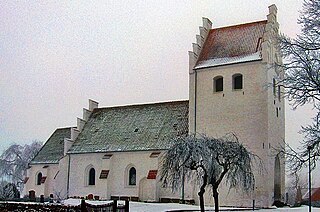
Errindlev Church is located in the village of Errindlev some 8 km northwest of Rødby on the Danish island of Lolland. Dating from the second half of the 12th century, the church has a Romanesque chancel and nave.

Halsted Church stands in the little village of Halsted some 6 km east of Nakskov on the Danish island of Lolland. Dating from the second half of the 12th century, the church has a Romanesque chancel and nave, a large burial chapel from 1636 and a tower from 1877. The church was closely associated with Halsted Priory, which has not survived.

Nakskov Church is the largest church in Nakskov on the west coast of the Danish island of Lolland. As Nakskov was mentioned in Valdemar's Census Book in the 13th century, the church probably dates to the same period.
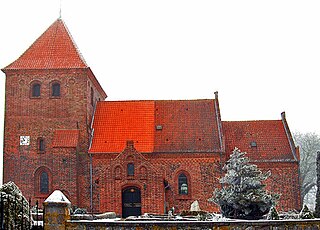
Tågerup Church is a Romanesque parish church located 4 km southeast of Rødby on the Danish island of Lolland. Dating from the beginning of the 13th century, its nave is richly decorated with early 16th-century frescos painted by the Brarup workshop.
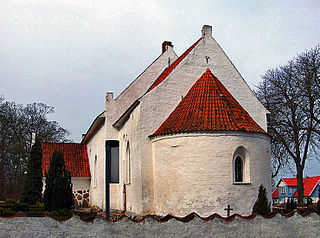
Arninge Church is a Late Romanesque church in the little village of Arninge, some 8 km (5.0 mi) south of Nakskov on the Danish island of Lolland. Built of red brick in the 13th century, it has an intricately carved auricular altarpiece created by Henrik Werner in 1644.

Gloslunde Church is a Romanesque church east of Dannemare, some 13 km (8.1 mi) southeast of Nakskov on the Danish island of Lolland. Now whitewashed, it was built of red brick in the 13th century. The heritage listed Gloslunde Rectory is located next to the church.
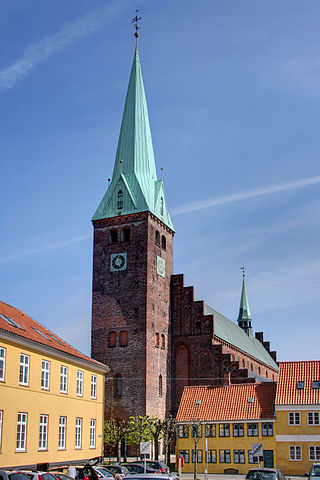
Saint Olaf's Church is the cathedral church of Helsingør in the north of Zealand, Denmark. With a history going back to around 1200, the present building was completed in 1559. In 1961, the church was given the status of cathedral in connection with the establishment of the Diocese of Helsingør.

Saint Jørgensbjerg Church is a historic church in Roskilde on the Danish island of Zealand. With a nave and chancel in travertine limestone dating from c. 1080, it is Denmark's oldest preserved stone building.

St Martin's Church is a red brick church in Randers in the north of Jutland, Denmark. It was built from 1494 to 1520 on the site of an earlier church which was first mentioned in 1346.























